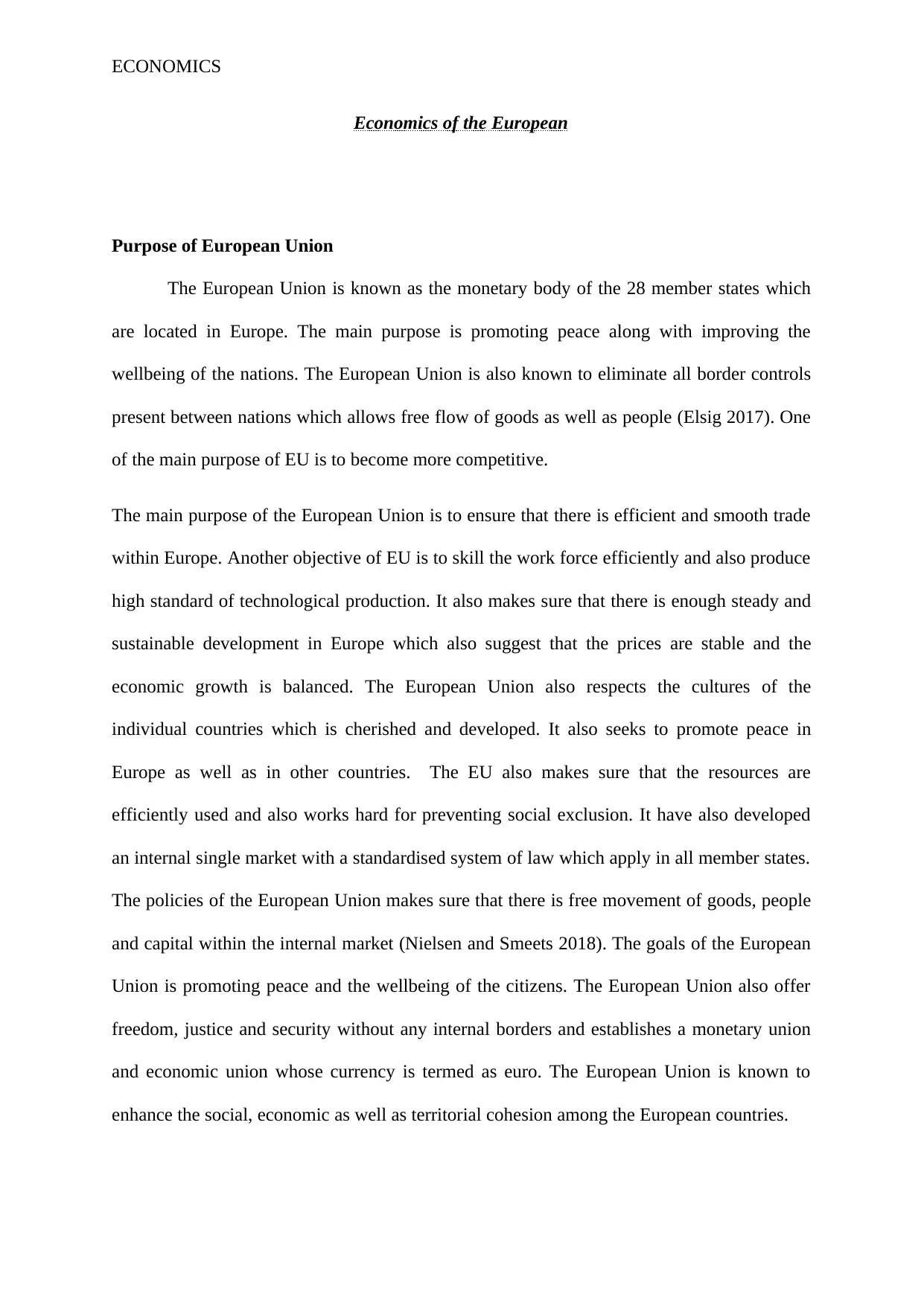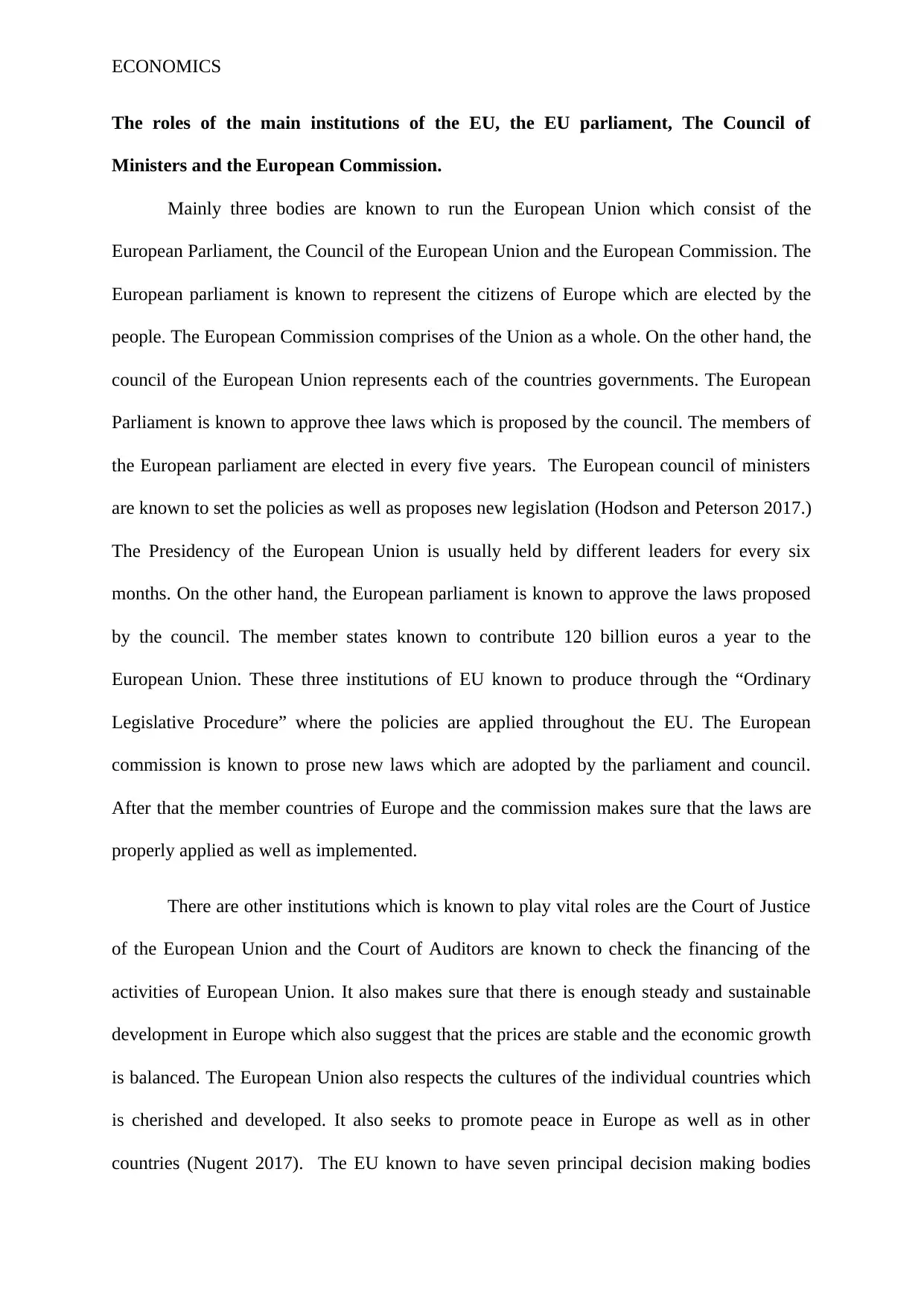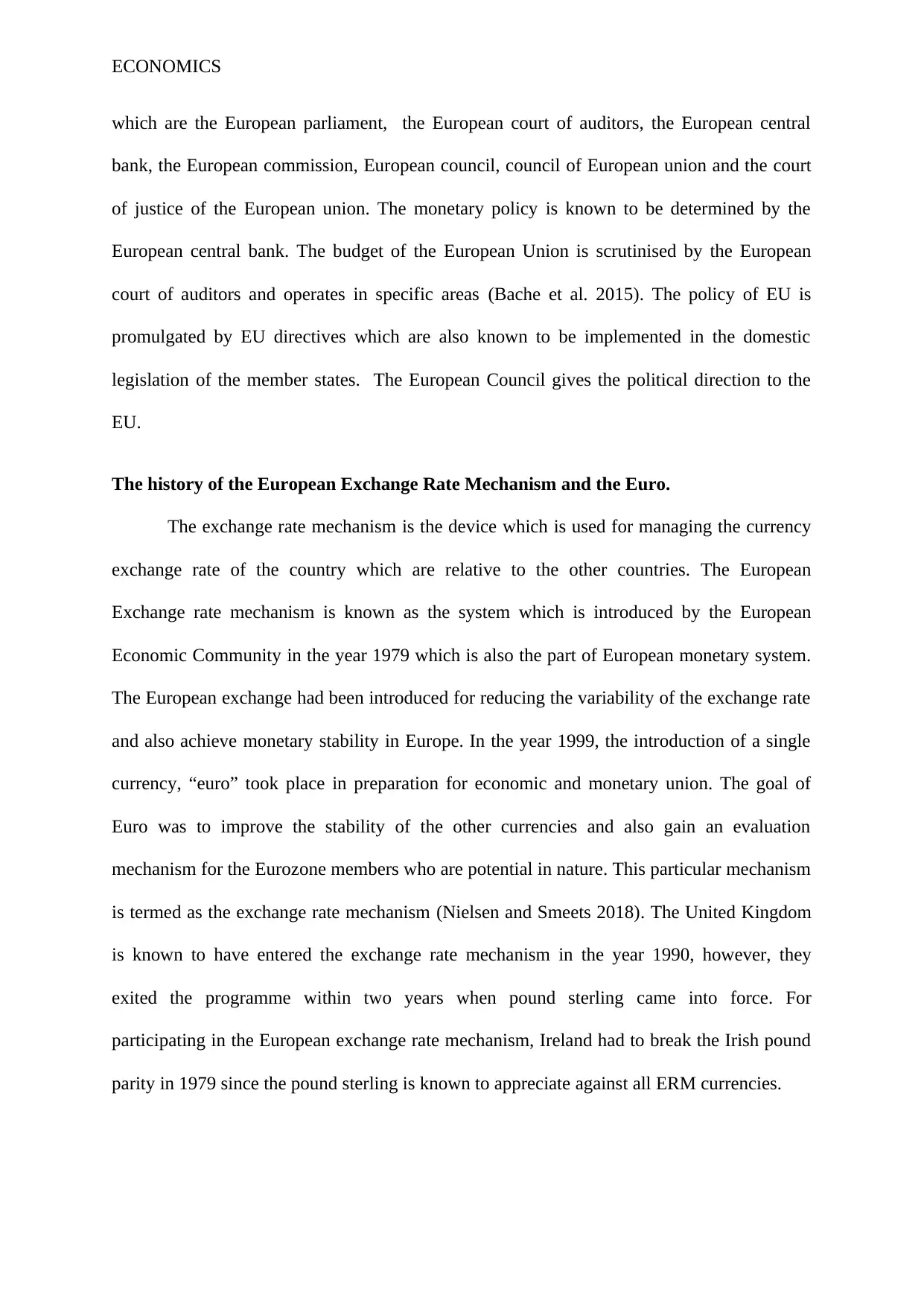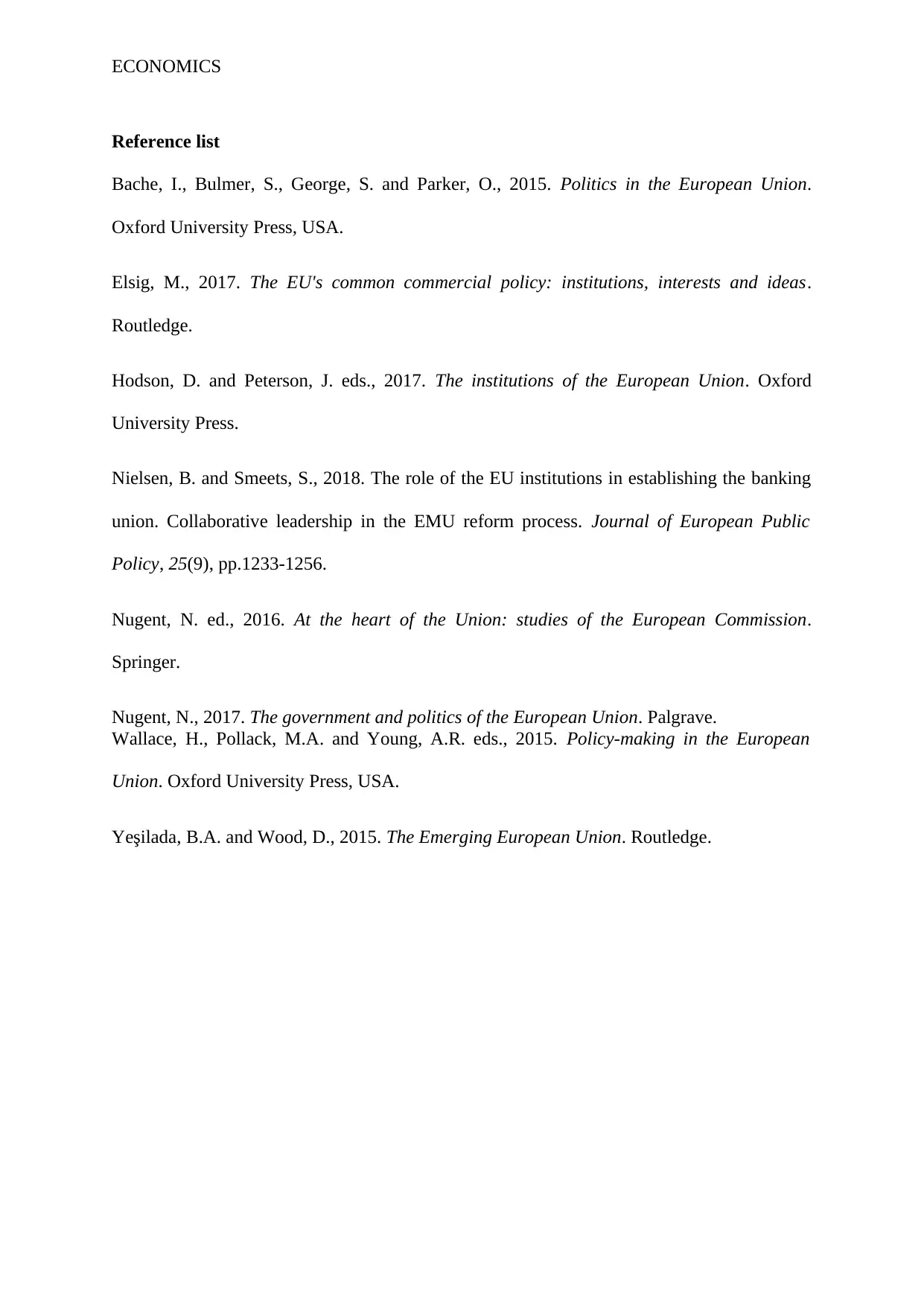A Comprehensive Analysis of the Economics of the European Union
VerifiedAdded on 2023/01/20
|5
|1273
|47
Report
AI Summary
This report provides a comprehensive overview of the economics of the European Union (EU). It begins by outlining the EU's primary purpose: promoting peace, improving the well-being of its member nations, and ensuring efficient trade and technological advancement. The report then delves into the roles of the main EU institutions, including the European Parliament, the Council of Ministers, and the European Commission, detailing their functions and how they interact within the EU's legislative process. Furthermore, it explores the history of the European Exchange Rate Mechanism (ERM) and the introduction of the Euro, examining their roles in achieving monetary stability and facilitating economic integration within Europe. The report also touches upon the roles of other key institutions, such as the Court of Justice and the Court of Auditors. This analysis is supported by relevant academic references and provides a valuable resource for students studying the economics and political structure of the European Union.

Running head: ECONOMICS
Economics
Name of thee university
Name of the student
Author note
Economics
Name of thee university
Name of the student
Author note
Paraphrase This Document
Need a fresh take? Get an instant paraphrase of this document with our AI Paraphraser

ECONOMICS
Economics of the European
Purpose of European Union
The European Union is known as the monetary body of the 28 member states which
are located in Europe. The main purpose is promoting peace along with improving the
wellbeing of the nations. The European Union is also known to eliminate all border controls
present between nations which allows free flow of goods as well as people (Elsig 2017). One
of the main purpose of EU is to become more competitive.
The main purpose of the European Union is to ensure that there is efficient and smooth trade
within Europe. Another objective of EU is to skill the work force efficiently and also produce
high standard of technological production. It also makes sure that there is enough steady and
sustainable development in Europe which also suggest that the prices are stable and the
economic growth is balanced. The European Union also respects the cultures of the
individual countries which is cherished and developed. It also seeks to promote peace in
Europe as well as in other countries. The EU also makes sure that the resources are
efficiently used and also works hard for preventing social exclusion. It have also developed
an internal single market with a standardised system of law which apply in all member states.
The policies of the European Union makes sure that there is free movement of goods, people
and capital within the internal market (Nielsen and Smeets 2018). The goals of the European
Union is promoting peace and the wellbeing of the citizens. The European Union also offer
freedom, justice and security without any internal borders and establishes a monetary union
and economic union whose currency is termed as euro. The European Union is known to
enhance the social, economic as well as territorial cohesion among the European countries.
Economics of the European
Purpose of European Union
The European Union is known as the monetary body of the 28 member states which
are located in Europe. The main purpose is promoting peace along with improving the
wellbeing of the nations. The European Union is also known to eliminate all border controls
present between nations which allows free flow of goods as well as people (Elsig 2017). One
of the main purpose of EU is to become more competitive.
The main purpose of the European Union is to ensure that there is efficient and smooth trade
within Europe. Another objective of EU is to skill the work force efficiently and also produce
high standard of technological production. It also makes sure that there is enough steady and
sustainable development in Europe which also suggest that the prices are stable and the
economic growth is balanced. The European Union also respects the cultures of the
individual countries which is cherished and developed. It also seeks to promote peace in
Europe as well as in other countries. The EU also makes sure that the resources are
efficiently used and also works hard for preventing social exclusion. It have also developed
an internal single market with a standardised system of law which apply in all member states.
The policies of the European Union makes sure that there is free movement of goods, people
and capital within the internal market (Nielsen and Smeets 2018). The goals of the European
Union is promoting peace and the wellbeing of the citizens. The European Union also offer
freedom, justice and security without any internal borders and establishes a monetary union
and economic union whose currency is termed as euro. The European Union is known to
enhance the social, economic as well as territorial cohesion among the European countries.

ECONOMICS
The roles of the main institutions of the EU, the EU parliament, The Council of
Ministers and the European Commission.
Mainly three bodies are known to run the European Union which consist of the
European Parliament, the Council of the European Union and the European Commission. The
European parliament is known to represent the citizens of Europe which are elected by the
people. The European Commission comprises of the Union as a whole. On the other hand, the
council of the European Union represents each of the countries governments. The European
Parliament is known to approve thee laws which is proposed by the council. The members of
the European parliament are elected in every five years. The European council of ministers
are known to set the policies as well as proposes new legislation (Hodson and Peterson 2017.)
The Presidency of the European Union is usually held by different leaders for every six
months. On the other hand, the European parliament is known to approve the laws proposed
by the council. The member states known to contribute 120 billion euros a year to the
European Union. These three institutions of EU known to produce through the “Ordinary
Legislative Procedure” where the policies are applied throughout the EU. The European
commission is known to prose new laws which are adopted by the parliament and council.
After that the member countries of Europe and the commission makes sure that the laws are
properly applied as well as implemented.
There are other institutions which is known to play vital roles are the Court of Justice
of the European Union and the Court of Auditors are known to check the financing of the
activities of European Union. It also makes sure that there is enough steady and sustainable
development in Europe which also suggest that the prices are stable and the economic growth
is balanced. The European Union also respects the cultures of the individual countries which
is cherished and developed. It also seeks to promote peace in Europe as well as in other
countries (Nugent 2017). The EU known to have seven principal decision making bodies
The roles of the main institutions of the EU, the EU parliament, The Council of
Ministers and the European Commission.
Mainly three bodies are known to run the European Union which consist of the
European Parliament, the Council of the European Union and the European Commission. The
European parliament is known to represent the citizens of Europe which are elected by the
people. The European Commission comprises of the Union as a whole. On the other hand, the
council of the European Union represents each of the countries governments. The European
Parliament is known to approve thee laws which is proposed by the council. The members of
the European parliament are elected in every five years. The European council of ministers
are known to set the policies as well as proposes new legislation (Hodson and Peterson 2017.)
The Presidency of the European Union is usually held by different leaders for every six
months. On the other hand, the European parliament is known to approve the laws proposed
by the council. The member states known to contribute 120 billion euros a year to the
European Union. These three institutions of EU known to produce through the “Ordinary
Legislative Procedure” where the policies are applied throughout the EU. The European
commission is known to prose new laws which are adopted by the parliament and council.
After that the member countries of Europe and the commission makes sure that the laws are
properly applied as well as implemented.
There are other institutions which is known to play vital roles are the Court of Justice
of the European Union and the Court of Auditors are known to check the financing of the
activities of European Union. It also makes sure that there is enough steady and sustainable
development in Europe which also suggest that the prices are stable and the economic growth
is balanced. The European Union also respects the cultures of the individual countries which
is cherished and developed. It also seeks to promote peace in Europe as well as in other
countries (Nugent 2017). The EU known to have seven principal decision making bodies
⊘ This is a preview!⊘
Do you want full access?
Subscribe today to unlock all pages.

Trusted by 1+ million students worldwide

ECONOMICS
which are the European parliament, the European court of auditors, the European central
bank, the European commission, European council, council of European union and the court
of justice of the European union. The monetary policy is known to be determined by the
European central bank. The budget of the European Union is scrutinised by the European
court of auditors and operates in specific areas (Bache et al. 2015). The policy of EU is
promulgated by EU directives which are also known to be implemented in the domestic
legislation of the member states. The European Council gives the political direction to the
EU.
The history of the European Exchange Rate Mechanism and the Euro.
The exchange rate mechanism is the device which is used for managing the currency
exchange rate of the country which are relative to the other countries. The European
Exchange rate mechanism is known as the system which is introduced by the European
Economic Community in the year 1979 which is also the part of European monetary system.
The European exchange had been introduced for reducing the variability of the exchange rate
and also achieve monetary stability in Europe. In the year 1999, the introduction of a single
currency, “euro” took place in preparation for economic and monetary union. The goal of
Euro was to improve the stability of the other currencies and also gain an evaluation
mechanism for the Eurozone members who are potential in nature. This particular mechanism
is termed as the exchange rate mechanism (Nielsen and Smeets 2018). The United Kingdom
is known to have entered the exchange rate mechanism in the year 1990, however, they
exited the programme within two years when pound sterling came into force. For
participating in the European exchange rate mechanism, Ireland had to break the Irish pound
parity in 1979 since the pound sterling is known to appreciate against all ERM currencies.
which are the European parliament, the European court of auditors, the European central
bank, the European commission, European council, council of European union and the court
of justice of the European union. The monetary policy is known to be determined by the
European central bank. The budget of the European Union is scrutinised by the European
court of auditors and operates in specific areas (Bache et al. 2015). The policy of EU is
promulgated by EU directives which are also known to be implemented in the domestic
legislation of the member states. The European Council gives the political direction to the
EU.
The history of the European Exchange Rate Mechanism and the Euro.
The exchange rate mechanism is the device which is used for managing the currency
exchange rate of the country which are relative to the other countries. The European
Exchange rate mechanism is known as the system which is introduced by the European
Economic Community in the year 1979 which is also the part of European monetary system.
The European exchange had been introduced for reducing the variability of the exchange rate
and also achieve monetary stability in Europe. In the year 1999, the introduction of a single
currency, “euro” took place in preparation for economic and monetary union. The goal of
Euro was to improve the stability of the other currencies and also gain an evaluation
mechanism for the Eurozone members who are potential in nature. This particular mechanism
is termed as the exchange rate mechanism (Nielsen and Smeets 2018). The United Kingdom
is known to have entered the exchange rate mechanism in the year 1990, however, they
exited the programme within two years when pound sterling came into force. For
participating in the European exchange rate mechanism, Ireland had to break the Irish pound
parity in 1979 since the pound sterling is known to appreciate against all ERM currencies.
Paraphrase This Document
Need a fresh take? Get an instant paraphrase of this document with our AI Paraphraser

ECONOMICS
Reference list
Bache, I., Bulmer, S., George, S. and Parker, O., 2015. Politics in the European Union.
Oxford University Press, USA.
Elsig, M., 2017. The EU's common commercial policy: institutions, interests and ideas.
Routledge.
Hodson, D. and Peterson, J. eds., 2017. The institutions of the European Union. Oxford
University Press.
Nielsen, B. and Smeets, S., 2018. The role of the EU institutions in establishing the banking
union. Collaborative leadership in the EMU reform process. Journal of European Public
Policy, 25(9), pp.1233-1256.
Nugent, N. ed., 2016. At the heart of the Union: studies of the European Commission.
Springer.
Nugent, N., 2017. The government and politics of the European Union. Palgrave.
Wallace, H., Pollack, M.A. and Young, A.R. eds., 2015. Policy-making in the European
Union. Oxford University Press, USA.
Yeşilada, B.A. and Wood, D., 2015. The Emerging European Union. Routledge.
Reference list
Bache, I., Bulmer, S., George, S. and Parker, O., 2015. Politics in the European Union.
Oxford University Press, USA.
Elsig, M., 2017. The EU's common commercial policy: institutions, interests and ideas.
Routledge.
Hodson, D. and Peterson, J. eds., 2017. The institutions of the European Union. Oxford
University Press.
Nielsen, B. and Smeets, S., 2018. The role of the EU institutions in establishing the banking
union. Collaborative leadership in the EMU reform process. Journal of European Public
Policy, 25(9), pp.1233-1256.
Nugent, N. ed., 2016. At the heart of the Union: studies of the European Commission.
Springer.
Nugent, N., 2017. The government and politics of the European Union. Palgrave.
Wallace, H., Pollack, M.A. and Young, A.R. eds., 2015. Policy-making in the European
Union. Oxford University Press, USA.
Yeşilada, B.A. and Wood, D., 2015. The Emerging European Union. Routledge.
1 out of 5
Related Documents
Your All-in-One AI-Powered Toolkit for Academic Success.
+13062052269
info@desklib.com
Available 24*7 on WhatsApp / Email
![[object Object]](/_next/static/media/star-bottom.7253800d.svg)
Unlock your academic potential
Copyright © 2020–2025 A2Z Services. All Rights Reserved. Developed and managed by ZUCOL.




